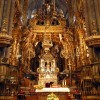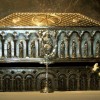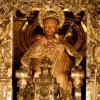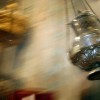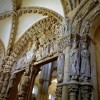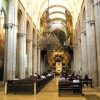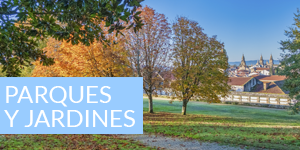- Accede I
- Regístrate I
- carrito
Altar mayor
El altar mayor da muestra de la fastuosa intervención de la arquitectura barroca en la Catedral románica. Para ‘adecentar’ el antiguo altar del s. XII, se le rodeó de 36 columnas salomónicas redoradas y cubiertas de pámpanos. Finalmente se sustituyó el altar románico por el actual platal barroco, presidido por Santiago en hábito de peregrino, sobre el que se colocó el espectacular baldaquín sostenido por ángeles y coronado por la efigie ecuestre del Apóstol y el escudo de España.
El esplendor del altar mayor aumentó cuando se añadieron las rejas, se policromaron las bóvedas y se pavimentó el conjunto en mármol. El trabajo de Peña de Toro fue completado por el maestro Domingo Andrade, con maderas doradas, mármoles, jaspes y plata; y por los órganos del s. XVIII, decorados por Miguel de Romay. De la cúpula octogonal pueden verse colgar, frente al altar, la cuerda y el sistema de poleas ideado en el s. XVI para poner en marcha el famoso Botafumeiro.
Ritos de la peregrinación
En el altar mayor tienen lugar la Misa del Peregrino, todos los días a las 12 y a las 19:30, y los rituales que cumplen los fieles en la Catedral. Subiendo por las escaleras al camarín, los visitantes siguen la costumbre de dar un abrazo al Santiago sedente con esclavina de peregrino, figura románica del s. XIII, y admirar la vista de la nave principal.
Seguidamente es tradición bajar del camarín para visitar las reliquias del Apóstol Santiago y sus discípulos Atanasio y Teodoro en el pequeño mausoleo subterráneo. Esta zona de culto, la más antigua de la Catedral, corresponde al panteón romano original, que había sido cegado en el s. XII por el arzobispo Gelmírez. Curiosmente hasta el s. XIX los fieles no podían visitar las reliquias, que de hecho estaban ‘desaparecidas’ desde el s. XVI. Sucedió que en 1589 fueron ocultadas para evitar que las robara sir Francis Drake y las trasladase a Inglaterra. Pero el pirata finalmente ni siquiera llegó a Compostela. En 1879, durante las excavaciones arqueológicas del templo, las osamentas fueron redescubiertas en el trasaltar. Tras la certificación papal de su autenticidad, las reliquias del Apóstol se colocaron en una urna de plata cincelada del s. XIX y el sepulcro adquirió su aspecto actual.












